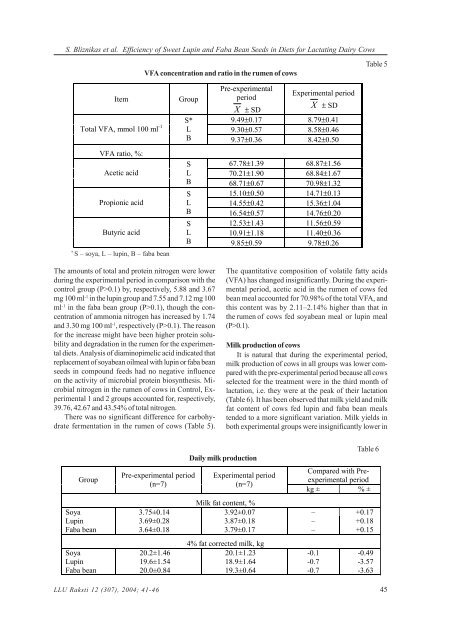saturs - Latvijas LauksaimniecÄ«bas universitÄte
saturs - Latvijas LauksaimniecÄ«bas universitÄte
saturs - Latvijas LauksaimniecÄ«bas universitÄte
- No tags were found...
Create successful ePaper yourself
Turn your PDF publications into a flip-book with our unique Google optimized e-Paper software.
S. Bliznikas et al. Efficiency of Sweet Lupin and Faba Bean Seeds in Diets for Lactating Dairy CowsVFA concentration and ratio in the rumen of cowsTable 5ItemGroupPre-experimentalperiodX ± SDExperimental periodX ± SDTotal VFA, mmol 100 ml -1 L9.30±0.57 8.58±0.46S*9.49±0.17 8.79±0.41B 9.37±0.36 8.42±0.50VFA ratio, %:Acetic acidPropionic acidButyric acid*S – soya, L – lupin, B – faba beanS67.78±1.39 68.87±1.56L70.21±1.90 68.84±1.67B 68.71±0.67 70.98±1.32S15.10±0.50 14.71±0.13L14.55±0.42 15.36±1.04B 16.54±0.57 14.76±0.20S12.53±1.43 11.56±0.59L10.91±1.18 11.40±0.36B 9.85±0.59 9.78±0.26The amounts of total and protein nitrogen were lowerduring the experimental period in comparison with thecontrol group (P>0.1) by, respectively, 5.88 and 3.67mg 100 ml -1 in the lupin group and 7.55 and 7.12 mg 100ml -1 in the faba bean group (P>0.1), though the concentrationof ammonia nitrogen has increased by 1.74and 3.30 mg 100 ml -1 , respectively (P>0.1). The reasonfor the increase might have been higher protein solubilityand degradation in the rumen for the experimentaldiets. Analysis of diaminopimelic acid indicated thatreplacement of soyabean oilmeal with lupin or faba beanseeds in compound feeds had no negative influenceon the activity of microbial protein biosynthesis. Microbialnitrogen in the rumen of cows in Control, Experimental1 and 2 groups accounted for, respectively,39.76, 42.67 and 43.54% of total nitrogen.There was no significant difference for carbohydratefermentation in the rumen of cows (Table 5).The quantitative composition of volatile fatty acids(VFA) has changed insignificantly. During the experimentalperiod, acetic acid in the rumen of cows fedbean meal accounted for 70.98% of the total VFA, andthis content was by 2.11–2.14% higher than that inthe rumen of cows fed soyabean meal or lupin meal(P>0.1).Milk production of cowsIt is natural that during the experimental period,milk production of cows in all groups was lower comparedwith the pre-experimental period because all cowsselected for the treatment were in the third month oflactation, i.e. they were at the peak of their lactation(Table 6). It has been observed that milk yield and milkfat content of cows fed lupin and faba bean mealstended to a more significant variation. Milk yields inboth experimental groups were insignificantly lower inGroupPre-experimental period(n=7)Daily milk productionExperimental period(n=7)Table 6Compared with Preexperimentalperiodkg ± % ±Milk fat content, %Soya 3.75±0.14 3.92±0.07 – +0.17LupinFaba bean3.69±0.283.64±0.183.87±0.183.79±0.17––+0.18+0.154% fat corrected milk, kgSoya 20.2±1.46 20.1±1.23 -0.1 -0.49LupinFaba bean19.6±1.5420.0±0.8418.9±1.6419.3±0.64-0.7-0.7-3.57-3.63LLU Raksti 12 (307), 2004; 41-46 1-1845
















